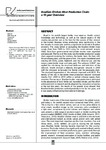Por favor, use este identificador para citar o enlazar este ítem:
http://www.alice.cnptia.embrapa.br/alice/handle/doc/1034965Registro completo de metadatos
| Campo DC | Valor | Lengua/Idioma |
|---|---|---|
| dc.contributor.author | NÄÄS, I. A. | pt_BR |
| dc.contributor.author | MOLLO NETO, M. | pt_BR |
| dc.contributor.author | CANUTO, S. A. | pt_BR |
| dc.contributor.author | WAKER, R. | pt_BR |
| dc.contributor.author | OLIVEIRA, D. R. M. S. | pt_BR |
| dc.contributor.author | VENDRAMETTO, O. | pt_BR |
| dc.date.accessioned | 2016-01-25T11:11:11Z | pt_BR |
| dc.date.available | 2016-01-25T11:11:11Z | pt_BR |
| dc.date.created | 2016-01-25 | pt_BR |
| dc.date.issued | 2015 | pt_BR |
| dc.identifier.citation | Revista Brasileira de Ciência Avícola, Campinas, v. 17, n. 1, p. 87-94, jan./mar. 2015. | pt_BR |
| dc.identifier.uri | http://www.alice.cnptia.embrapa.br/alice/handle/doc/1034965 | pt_BR |
| dc.description | Brazil is the world's largest broiler meat exporter. Health control, knowledge and technology, as well as the natural aspects of the country are pointed out as the keys for the success of that product in the market. Brazilian broiler production grew significantly in the last decade; it creates jobs and has a significant social role in Brazilian economy. This study aimed at evaluating the Brazilian broiler meat supply chain from 2000 to 2010 using the social network analysis (SNA). Data from governmental and private sources were organized and analyzed. The focus of this study was the broiler production supply chain segment involving the hatchery, the broiler farm, the feed mill, the processing plant, and the government. The inputs considered were one-day-old chicks, pullet, feedstuff, and the infrastructure; and the outputs were broiler meat and taxes paid. The software UCINET was applied for calculating the structural attributes and indicators of the network. Results showed a relatively disorganized network in 2000 with the strongest tie between the farmer and the processing plant. The structural organization of the network improved until 2010. The density of the ties in the broiler meat production network increased steadily from 2000 to 2010 within a vertical cohesive supply chain structure. The success of Brazilian broiler meat production is attributed to the abundance of land, fertile soil, favorable climate, and the effort and investments in research and development by innovative companies in the last few years. The results of the present study showed that Brazilian broiler production evolved positively in the last ten years, and it was weakly influenced by international challenges. | pt_BR |
| dc.language.iso | eng | eng |
| dc.rights | openAccess | eng |
| dc.subject | Redes sociais | pt_BR |
| dc.subject | Mercado de carne | pt_BR |
| dc.subject | Cadeia de produção do frango | pt_BR |
| dc.subject | Broiler meat supply chain | pt_BR |
| dc.subject | Social network analysis | pt_BR |
| dc.title | Brazilian chicken meat production chain: a 10-year overview. | pt_BR |
| dc.type | Artigo de periódico | pt_BR |
| dc.date.updated | 2016-01-25T11:11:11Z | pt_BR |
| dc.subject.thesagro | Frango | pt_BR |
| dc.subject.nalthesaurus | Broiler chickens | pt_BR |
| dc.subject.nalthesaurus | Social networks | pt_BR |
| dc.description.notes | Brazilian Journal of Poultry Science. | pt_BR |
| riaa.ainfo.id | 1034965 | pt_BR |
| riaa.ainfo.lastupdate | 2016-01-25 | pt_BR |
| dc.identifier.doi | http://dx.doi.org/10.1590/1516-635x170187-94 | pt_BR |
| dc.contributor.institution | Unip; Unip; Unip; Unip; DEISE ROCHA MARTINS DOS SANTOS OLIVEIRA, CNPTIA; Unip. | pt_BR |
| Aparece en las colecciones: | Artigo em periódico indexado (CNPTIA)  | |
Ficheros en este ítem:
| Fichero | Descripción | Tamaño | Formato | |
|---|---|---|---|---|
| BrazilianchickenNaas.pdf | 341.73 kB | Adobe PDF |  Visualizar/Abrir |









